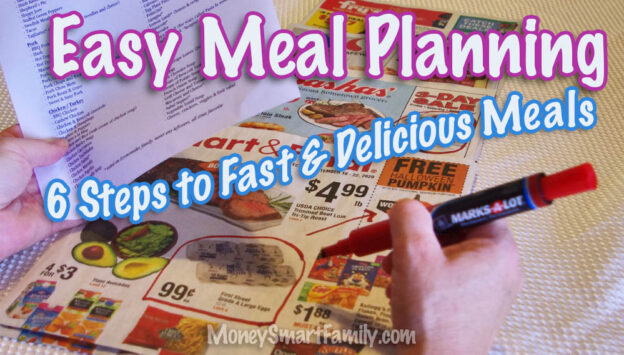Meal planning seems to be one of the trendiest things to be doing now. Whether you’re into weight training, catering to a specific lifestyle choice (vegan, keto, paleo, etc.), eating organic or just doing menu planning to save time—this will help you eat healthier for less.
Annette and Steve started meal-prepping more than 30 years ago to feed their growing family of seven. Annette has tried many different ways of doing meal planning and has fine-tuned it to be efficient and tasty.
TABLE OF CONTENTS
What the Difference Between Meal Planning & Meal Prepping
Menu Planning and Meal Prepping are two amazing tools that will help you to put dinner on the table easier and cheaper.
- Meal Planning – that’s what this article will help you do. It’s creating a written plan for each day’s evening meal including a protein, starch and veggie. We try to incorporate ingredients we already have in the house.
- Meal Prepping – The process of preparing the ingredients for multiple meals. Read our Bulk Cooking article to learn how we do it.
Keep reading to learn how Annette went from a meal-planning novice to a menu-planning expert.
6 Easy Steps to Meal Planning
So, here’s what we did to make what may seem like an overwhelming process a little less stressful. This is something you can work into your family routine if you’re willing to take a little time to modify your current system.
Initially, Annette made a meal plan only for dinner meals. Once she had that down, she created a rotation of breakfast and lunch meals also.
We understand that our process may not work for every family. But, if the primary chef in your clan can take tidbits from this article and use them to ‘streamline’ your meal prepping, you’ll be on your way to saving tons of time and money!
Step 1: Take Stock of Food in the House
Early in the week, before we go grocery shopping, one of us takes stock of what we have in our pantry, refrigerator, and freezer. When the kids were all at home we would do one big shopping trip each month. Now we go about twice a month.
We take stock of food in the following categories:
a. Breakfast Foods In The House
These are the staples we usually have in stock for breakfast:
- Eggs
- Potatoes (for hash browns)
- Shredded Cheese (for scrambled eggs)
- Bread
- Bagels
- Oatmeal (regular and instant)
- Cold cereal
- Ingredients for pancakes (see Steve’s Super Delicious Pancake recipe), French toast and waffles.
Annette makes sure the pantry is stocked with flour, sugar, baking powder, baking soda, vanilla, cinnamon and other ingredients for making breakfast meals.
b. Lunch Ingredients In the House
Here is our go-to list of lunch ingredients that we always have in stock:
- Peanut butter
- Jelly
- Canned tuna/ salmon
- Lunch meat
- Bread
- Tortillas
- Shredded and Chunk cheese,
- Hard-boiled eggs
- Yogurt
- Cottage Cheese
- Hot dogs
- Salad fixings
- Plenty of fruit (in season).
- And, of course, Steve ‘has to have’ marshmallow cream for fluffer nutters on tortillas just in case…
c. Dinner Components in the House
Annette looks at general categories, counting the number of main dish components she has in the freezer in each of the following categories before preparing her menu:
- Beef
- Chicken/Turkey
- Pork/Ham
- Lamb
- Pasta
- Beans/Lentils
- Ingredients for meatless meals
(read more about how we inventory our freezer here)
She also takes inventory of other fruits, veggies and starches we have in the house. These will be used as side dishes for many of the dinners and some of the lunches.
The list below includes most, but not all of the fruits, veggies and starches we eat.
Step 2: Check the Ads for Grocery Store Sales
Once we’ve taken inventory, Annette checks the grocery store ads for sale items.
Get more details on how Annette assembles her Grocery Shopping list here.
She likes to use physical, printed ads and circle the sale items. But you could use your grocer’s app or Flipp.com to see what’s on sale.
Annette looks at the ads to purchase discounted items (loss leaders) to stock our freezer. She’s always shopping ahead and buying discounted food that will store well. Most of the sale items won’t be eaten this month.
She also looks for sales on in-season produce, frozen veggies, cereal and other staples.
Then, having determined what sale items she will buy, Annette starts to create the month’s meal-prepping plan. Most of her main dish selections are based on what she already has in the freezer.
How We BUDGET To Have Money to Stock Up on Sales
In our household budget system, we set aside our grocery money in advance for each month. There are times our food budget has extra money in it to take advantage of yearly special sale prices.
We use this excess cash for turkeys at Thanksgiving, hams at Christmas, and corned beef for St. Patty’s Day. Stocking up in advance saves you LOADS of money in the long run!– So, don’t neglect this tip!
Learn more about Grocery Store Sales Cycles and what we stock up on in this blog.
Step 3: Meal Planning With A Variety of ‘Go-To’ Fav Recipes
For effective meal planning, you’ll need to have a number of recipes that you can prepare. This repertoire will grow over time.
Variety is the spice of life! And, we can think of nothing better than greeting each week with a varied assortment of yummy options.
But, what do you do if you are “meal plan-challenged”, or simply have a limited cooking repertoire?
How to Expand Your Recipe Repertoire
Early in our marriage, Annette grew tired of making the same meals over again, so she invited some friends over for a “recipe swap.”
Best idea EVER, let me tell you!
She came away with a variety of recipes and fresh enthusiasm and creativity to keep our dinner meals exciting. It’s also where her famous Christmas Pumpkin Bread recipe came from!
Other Places to Find New Recipes
And if none of the options she has on the list sound appealing, her go-to place for recipe searching is Pinterest.
Pinterest: Be sure to check out our Pinterest Best Recipes of MoneySmart Family Boards. Or build your own boards where you can ‘Pin’ your favorites and give them a shot! There are so many food bloggers out there now, and countless websites– Everything is literally at your fingertips!
MoneySmart Family Recipes: Or visit the Recipes landing page of our website. Each recipe we post comes with a printable.pdf and many have video instructions that accompany them.
Our Recipes landing page is divided into:
- Bread Recipes
- Fruit Recipes
- Snack Recipes
- Dessert Recipes
- Main Dishes (Beef, Chicken, Pork, and Vegetarian)
- Veggie Recipes
- Drink Recipes
- Starchy Side Dishes
Dining on a Dime Best-Selling cookbook with more than 1200 delicious recipes. This book was written and revised by our friend Tawra Kellam and her mom Jill Cooper. Learn more about the cookbook here.
Step 4: Building A Recipe/Meal Reference List
After years of planning, research and experimenting Annette now has more than 100 different recipes to choose from when she creates our monthly meal plan.
Years ago Steve typed up her 92 Meal List. The list is divided into 6 categories by the main ingredient:
- Beef Meals
- Pork Meals
- Chicken/Turkey Meals
- Ham Meals
- Greek/Italian Meals
- Meatless Meals
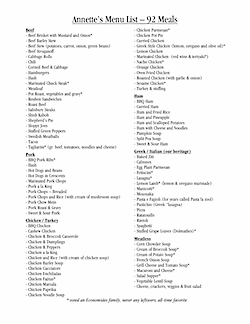
You could easily do the same thing. Build a list of the recipes you currently know how to cook and categorize them by the main ingredient.
This list is super helpful when planning a months-worth of meals.
For Annette, she’ll rotate the daily menu from a chicken to beef dish to pork or to a meatless dish, etc, trying not to repeat the same type of main ingredient two days in a row.
So if she’s stumped about a meal to include, she’ll look at the list and say, “I need a chicken meal, what sounds good?”
Then, for example, she’ll decide between Chicken Cacciatore, Lemon Chicken, or Oven Fried Chicken (or one of about 20 other options). If none of those are appealing she’ll go to her cookbooks or Pinterest for new ideas.
Overcoming a Meal Planning Roadblock
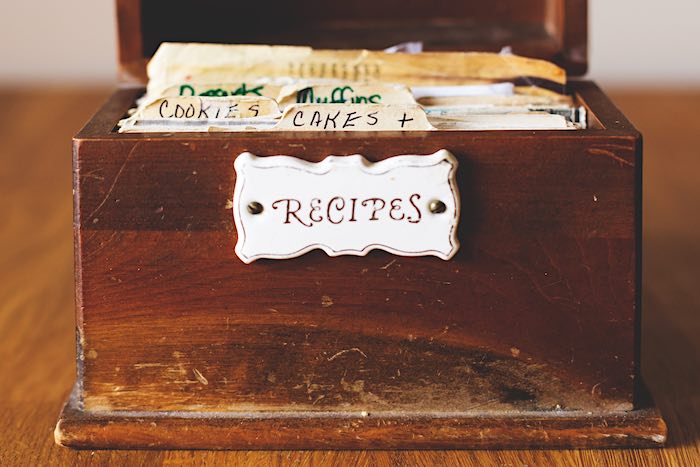
If you plan to become a hard-core, economizing meal planner, then you need to know the pitfalls.
For instance, about a year into Annette’s meal-planning journey, she ran into a “brick wall.”
The food ads offered no great sales and she didn’t have much variety in the freezer. The best meat deal she could find was a sale on Italian sausage at $1.50 per pound.
Previously she had used Italian sausage only in pasta dishes, so she began paging through her cookbooks (see our list of favorite cookbooks here).
As a result of that “bad ad” day, she discovered one of our all-time favorite meals – Italian Sausage Spinach Pie (not a very glamorous name, but quite descriptive and delicious).
The point is that sometimes a commitment to an economical approach to meal planning takes research and extra effort. But, the payoff is phenomenal – you save money and can broaden your culinary experiences in numerous ways!
Step 5: Meal Planning for Breakfast and Lunch
Making a breakfast and lunch meal plan is optional. Annette rarely planned specific meals for breakfast and lunch. Instead, she developed a rotation of meals and posted them on the refrigerator.
This was done when the kids were a little older so that they could prepare their own breakfast or lunch, or help prepare it for the family. It also prevented them from getting “stuck” having cold cereal every day.
a. Breakfast Meal Planning Rotation
We have a rotation of various meals for breakfast. This is an example of last week’s menu:
- Monday: Cold cereal / with bananas or berries
- Tuesday: Hot cereal with grapefruit
- Wednesday: Bagels with cream cheese or nut butter with melon
- Thursday: Eggs with toast & berries
- Friday: Cold cereal with bananas
- Saturday: Pancakes and sausages or bacon & fruit salad
- Sunday: Scrambled eggs with ham and potatoes
Often Steve cooks pancakes, French toast or waffles on the weekends. Then, we usually prepare a big batch (quadruple recipe). The leftovers are neatly packed into freezer storage bags and frozen. Then they are put into the rotation of meals during the week.
b. Lunch Meal Planning Rotation
This rotation varies greatly depending on what we have purchased on sale and have in the refrigerator. Here’s last week’s lunch menu:
- Monday: Yogurt with fruit and crackers (chips or pretzels)
- Tuesday: Mac and Cheese and bananas
- Wednesday: Tuna fish sandwiches and apples
- Thursday: PB&J with orange slices
- Friday: Leftovers
- Saturday: BLT’s (bacon, lettuce, and tomato sandwiches)
- Sunday: Lunchmeat sandwiches and pickles
Step 6. Assembling Your Dinner-Time Meal Plan
Finally, you’re ready for making your dinner menu plan. If you’re a newbie to meal planning, start small and build.
Beginner Planning. Don’t try to start by planning a month’s worth of meals. The first time Annette tried meal planning she planned 30 days of meals and it took her all day to come up with her meal plan.
But that was then.
Now she can get the planning done in about 30 minutes, and she only plans between 17 and 20 actual meals. The rest of the days are supplemented with leftovers or eating out at special events or restaurants (very infrequently).
If you’re just starting out, try planning for a few days or even a week.
Then as you become adept at planning stretch your plan to include more days.
Even if you just start with a few days, you’ll quickly relieve a lot of stress in your grocery and meal planning process.
4 Resources Needed for Dinner Meal Planning
- Recipe List
- Freezer Inventory
- Calendar
- Meal Planning Sheet
1. Meal/Recipe List: With her meal list is her reference for selecting a variety of meals.
2. Freezer Inventory: This lets her know exactly how much of each main ingredient she has on hand. Remember she plans based on what we have in the house. Get a free Freezer inventory template on this page.
3. Why a Calendar? Simple. She plans the meals based on our family’s schedule for the month. She didn’t want to cook a roast with side dishes on a night when Joseph had baseball practice or Becky had a night class. We like to sit down and eat as a family as often as possible.
4. Meal Planning Sheet
Our meal planning sheet fits 2 weeks’ worth of dinners on one page. In the box for each day Annette will list:
Each meal includes 3 components:
- Main Dish
- Vegetable
- Starch
- Activity for the night
So based on the day’s activities she’ll schedule a meal that fits.
We eat very few casseroles. We do eat meat, and always includes lots of veggies!
When Steve was deep in the corporate world and working longer hours, barbecued or grilled meals were reserved for weekends.
It is very infrequent that we actually shop for main dish ingredients to be used this month.
Starting Out: If this is your first meal plan and you don’t have a lot in stock, then plan your meals based on the main ingredients that you can find on sale this week. If chicken is discounted, then plan to have two or three chicken meals. If ground beef is on sale then do the same with that.
A Real-Life Dinner Plan – 2 Weeks
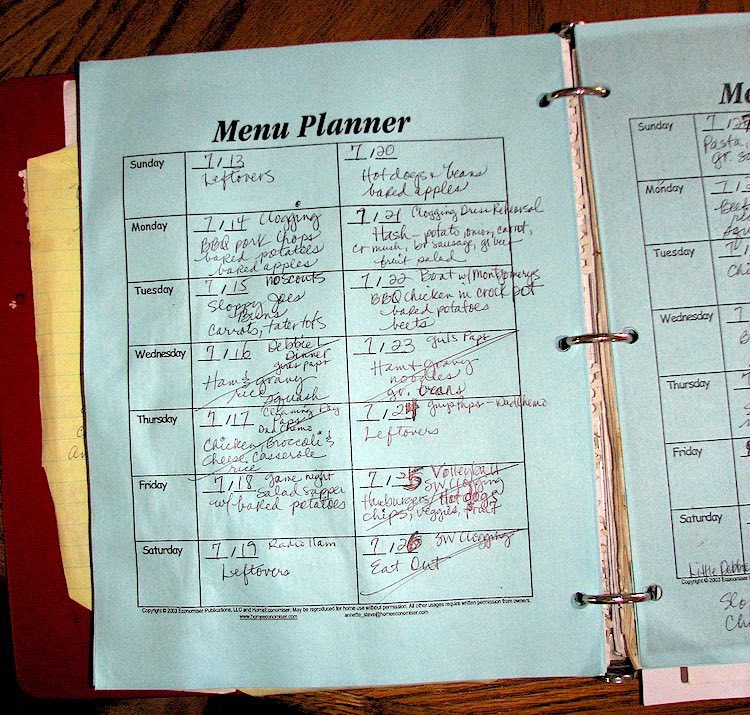
Click here to see a larger version
This particular two-week meal plan was during the summer and we had some sort of activity or guest for dinner almost every night.
Here’s what the menu plan consisted of:
Week 1:
- Sunday 7/13: Leftovers
- Monday 7/14: BBQ Pork Chops, Baked Potatoes, Baked Apples (Event Clogging Night)
- Tuesday 7/15: Sloppy Joes, Buns, Carrots, Tater Tots (Scouts)
- Wednesday 7/16: Ham and Gravy, Rice, Squash (Debbie L for Dinner / Girls Weight Lift am)
- Thursday 7/17: Chicken with Broccoli and Cheese Casserole with Rice (Guys & Steve Weight Lift pm)
- Friday 7/18: Salad Supper with Baked Potatoes (Game Night)
- Saturday 7/19: Leftovers
Week 2:
- Sunday 7/20: Hot Dogs, Beans and Baked Apples
- Monday 7/21: Hash (potato, onion, carrot, cr. mush, breakfast sausage, ground beef) (Clogging Dress Rehearsal)
- Tuesday 7/22: BBQ Chicken in the Crockpot, Baked Potatoes, Beets (Boat/Lake Day)
- Wednesday 7/23: Ham and Gravy, Noodles, Green Beans (Girls Weight Lift am)
- Thursday 7/24: Leftovers (Guys & Steve Weight Lift pm)
- Friday 7/25: Hamburgers, Hot Dogs, Chips, Veggies, Fruit (Volleyball Night)
- Saturday 7/26: Restaurant – Eat Out (Clogging Competition)
*= Freezer meal
Here are a few other dinner combinations in our monthly menu plan:
- Salisbury Steaks, baked potatoes, and broccoli.
- Chicken enchiladas, rice, and cauliflower.
- Marinated lamb chops (only if less than $2.99 per pound), yams and green beans
- Ham / scalloped potatoes and carrots.
- Minestrone soup with dinner rolls or cheese muffins.
Annette usually plans 15-18 dinner meals to be cooked on our once-a-month cooking day and stored in the freezer for use throughout the month. Then she fills in the remaining days with meals prepared on those days: roast chicken; pasta (sauce made earlier in the month); chops or steaks on the grill, etc., or leftovers.
Or she’ll cook a big batch of soup or some other recipe and serve some on the night planned and store the rest. in the freezer to be used sometime in the future.
Modified Recipes for Small Children
If you have small children (under 4 years old), you’ll love this idea. How often has this scenario played out at your house?
Dinner is finally on the table, the kids are seated, you drop into your chair – exhausted and famished. Then you spend the next 15 minutes cutting up the meal for the younger kids.
This process was especially daunting for Annette when Steve worked late.
As a result, many of the dinner meals she has developed, use cut-up or diced chicken, ham, turkey or beef.
Why Eating Leftovers is AWESOME!
Some families view leftovers as revolting. But in our home, when we announce that “Leftovers” are on the menu, there is usually a race to the kitchen to be first in line and first to choose. Each of our kids has their favorites. We view leftovers as a way to save time and money.
When Steve packed lunches to take to the office, they were usually the envy of everyone who saw or smelled them.
Do you realize what it costs to purchase a $6 lunch every workday? Do the math: 50 weeks times 5 days times $6– Fifteen hundred dollars per year! Even if you take leftovers two or three days each week, your savings will be significant. (And, of course, the savings can be put into paying off debt, retirement savings or a vacation)
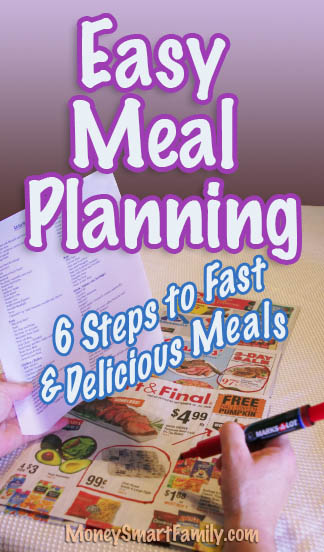
Summary of Meal Planning the Best Way
If you’re still overwhelmed with the prospect of planning 30 days’ worth of meals, remember that you can always start with fewer meals. Just doing a week’s worth of planning should reduce your mental panic time and also minimize trips to the store. Whatever you do, each bit of planning will provide minutes of freedom and peace.
A practice that Annette originally viewed as a burden has actually become a burden lifter for her. No matter who’s doing the cooking in your home, with a little practice, you can alleviate stress, save money and have a variety of meals that your family will love. It will also be affordable, balanced, and delicious! So start your plan and let us know when we should come over for dinner.
Meal Planning Resources
Here are some great resources that we use in our home:
- Download a free copy of our 2 Week Meal Planning Sheet (just give us your email address and we’ll give you the sheet.
- Learn some new easy recipes from our Recipe landing page (we’ve got hundreds of recipes on this site for free)
- Get some new ideas on using a Crock Pot to save you time cooking.
- Buy a copy of “Cut Your Grocery Bill in Half.” This is our #2 on Amazon best-selling grocery book. With so many money-saving strategies you won’t need to clip coupons.
- Buy our Grocery Forms Collection from our MoneySmart Printables Etsy Store for $6.98. It includes pdfs of the following forms:
- Grocery List
- Menu Planner
- Price Tracker
- Freezer Inventory


